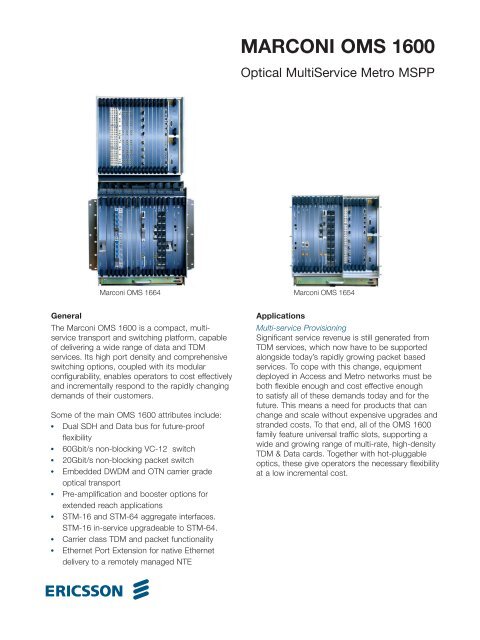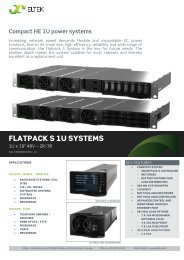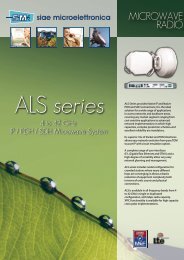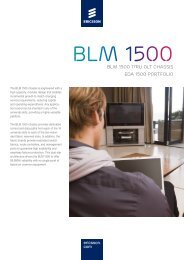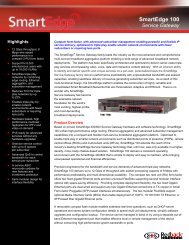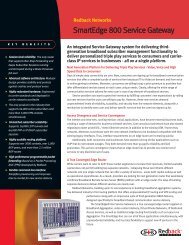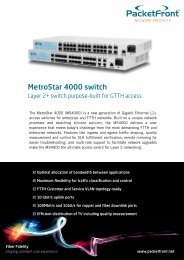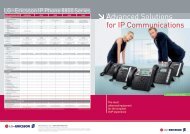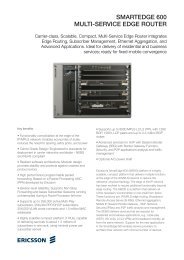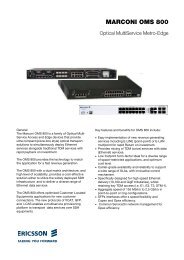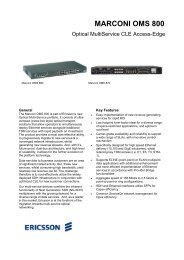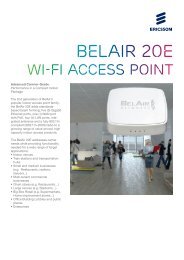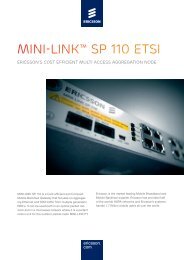marconi oms 1600
marconi oms 1600
marconi oms 1600
Create successful ePaper yourself
Turn your PDF publications into a flip-book with our unique Google optimized e-Paper software.
MARCONI OMS <strong>1600</strong><br />
Optical MultiService Metro MSPP<br />
Marconi OMS 1664<br />
Marconi OMS 1654<br />
General<br />
The Marconi OMS <strong>1600</strong> is a compact, multiservice<br />
transport and switching platform, capable<br />
of delivering a wide range of data and TDM<br />
services. Its high port density and comprehensive<br />
switching options, coupled with its modular<br />
configurability, enables operators to cost effectively<br />
and incrementally respond to the rapidly changing<br />
demands of their customers.<br />
Some of the main OMS <strong>1600</strong> attributes include:<br />
Dual SDH and Data bus for future-proof<br />
flexibility<br />
60Gbit/s non-blocking VC-12 switch<br />
20Gbit/s non-blocking packet switch<br />
Embedded DWDM and OTN carrier grade<br />
optical transport<br />
Pre-amplification and booster options for<br />
extended reach applications<br />
STM-16 and STM-64 aggregate interfaces.<br />
STM-16 in-service upgradeable to STM-64.<br />
Carrier class TDM and packet functionality<br />
Ethernet Port Extension for native Ethernet<br />
delivery to a remotely managed NTE<br />
Applications<br />
Multi-service Provisioning<br />
Significant service revenue is still generated from<br />
TDM services, which now have to be supported<br />
alongside today’s rapidly growing packet based<br />
services. To cope with this change, equipment<br />
deployed in Access and Metro networks must be<br />
both flexible enough and cost effective enough<br />
to satisfy all of these demands today and for the<br />
future. This means a need for products that can<br />
change and scale without expensive upgrades and<br />
stranded costs. To that end, all of the OMS <strong>1600</strong><br />
family feature universal traffic slots, supporting a<br />
wide and growing range of multi-rate, high-density<br />
TDM & Data cards. Together with hot-pluggable<br />
optics, these give operators the necessary flexibility<br />
at a low incremental cost.
Ethernet Service delivery<br />
The Ethernet cards support a wide range of Ethernet<br />
and Layer 2 VPN services, including<br />
E-Line, EPL (point to point)<br />
E-Line, EPL (point to point)<br />
E-LAN, EPLAN (multipoint to multipoint)<br />
Sharing a close synergy with Ericsson’s OMS 2400<br />
family of “carrier-class” Ethernet Transport products,<br />
both families can work together in the same<br />
network delivering MPLS services, including VPWS<br />
and VPLS. The integrated 20Gbit/s (40Gbit/s unidirectional)<br />
packet switch, together with provider<br />
Ethernet functionality makes the OMS <strong>1600</strong> an<br />
ideal delivery platform for both residential triple play<br />
and full carrier class business services.<br />
Mobile network application<br />
Mobile networks present unique problems to the<br />
transport equipment. At the edge of the optical<br />
RAN, the need is for an optical platform that can<br />
cost effectively hub 2Mbit/s from base stations,<br />
whereas at the controller site a larger platform is<br />
typically required to enable multiple RNC and BSCs<br />
to be collocated. The functionality required here is<br />
the ability to close multiple subtended rings, and<br />
groom/consolidate the traffic in a non-blocking<br />
VC12 switch. The introduction of IP base stations<br />
will mean that operators who can migrate existing<br />
2Mbit/s backhaul circuits to Ethernet technology<br />
can quickly take advantage of this more efficient<br />
packet transport. The OMS <strong>1600</strong> family fulfills all of<br />
these requirements; it has comprehensive 2Mbit/s<br />
capability and, at the same time, is able to optimize<br />
Ethernet transport through packet aggregation and<br />
statistical gain.<br />
Internet<br />
News<br />
Service and<br />
control<br />
Data<br />
Weather<br />
IP<br />
Video<br />
Gaming<br />
Entertainment<br />
Voice<br />
Transport<br />
Network<br />
OMS 800<br />
OMS <strong>1600</strong><br />
OMS 2400<br />
MHL 3200<br />
Common<br />
Network<br />
management<br />
OMS <strong>1600</strong><br />
OMS 1200<br />
OMS <strong>1600</strong><br />
OMS 2400<br />
MHL 3000<br />
MHL 3000<br />
Customer Access Metro Core<br />
Functionality<br />
Comprehensive Ethernet support.<br />
Standardized GFP, VCAT and LCAS functionality is<br />
used to map Ethernet traffic efficiently into VC-12,<br />
VC-3 or VC-4 VCGs.<br />
Two types of Ethernet cards are provided; mapping<br />
cards, optimized for point-to-point applications,<br />
and L2 cards offering full packet switching.<br />
Tri-rate ports are provided with configurable<br />
throughput up to wire speed and which can be presented<br />
as optical or electrical interfaces. A 10GigE<br />
port is supported on the central data switch.<br />
A separate data ‘bus’ removes the dependency on<br />
a central SDH switch, enabling the OMS <strong>1600</strong> to<br />
host traffic cards fully optimized for data applications.<br />
In this way, the OMS <strong>1600</strong> can readily migrate<br />
from an SDH ADM, say, to an Ethernet switch<br />
with no platform change.<br />
The OMS <strong>1600</strong> also supports Resilient Packet<br />
Ring, carrying RPR and TDM traffic separately in<br />
the same SDH bearer.<br />
Where remote delivery of Ethernet is required, the<br />
OMS <strong>1600</strong> supports Ericsson’s unique Ethernet<br />
Port Extension product, enabling native optical Ethernet<br />
to be delivered to a remotely managed NTE<br />
at a distance of up to 50km.
Choice of Shelf Types<br />
The OMS <strong>1600</strong> is available in two shelf types: a<br />
standard subrack supporting 16 traffic interface<br />
cards, and a compact version. Various options<br />
of switch sizes (currently 10Gbit/s, 20Gbit/s or<br />
60Gbit/s) can be fitted, as shown in the table<br />
below. When combined with the wide range of<br />
optical aggregate traffic cards and optional Ethernet<br />
Layer 2 cards, it is not surprising that the OMS<br />
<strong>1600</strong> has rapidly become established as the MSPP<br />
of choice for many of the world’s leading network<br />
operators.<br />
Shelf<br />
Switch size<br />
size 10G 20G 60G<br />
Full<br />
Compact<br />
Cost<br />
reduced<br />
504 x<br />
2Mbit/s<br />
Cost<br />
reduced<br />
Light<br />
loaded<br />
STM-16<br />
Metro Access<br />
High port<br />
count<br />
STM-16<br />
ADM<br />
Metro<br />
Access<br />
STM-64<br />
ADM<br />
DXC<br />
Metro Core<br />
STM-64<br />
ADM<br />
Metro<br />
Core<br />
In-service traffic upgrade<br />
If configured initially with STM-16 aggregates, the<br />
OMS <strong>1600</strong> can be later upgraded, in service, to<br />
STM-64, as traffic volumes increase.<br />
Flexible node application<br />
The full VC-12 connectivity of the 384 x 384 STM-<br />
1 (60 Gbit/s) switch allows the OMS <strong>1600</strong> to be<br />
used as a compact Lower Order full connectivity,<br />
non-blocking cross-connect. As an OCS, the OMS<br />
<strong>1600</strong> can cross-connect any combination of STM-<br />
64, STM-16, STM-4 or STM-1 for hub, mesh and<br />
ring closure topologies. Whether used as an MSPP,<br />
terminal, ADM or cross-connect the OMS <strong>1600</strong><br />
becomes a key enabler for simplifying and lowering<br />
the cost of network build.<br />
Embedded WDM<br />
CWDM or DWDM interfaces are provided through<br />
user selectable SFP modules. A fully tunable STM-<br />
64/OTM1r.2 (G.709) card is also available. WDM<br />
multiplexing is supported using integrated passive<br />
filters, or in conjunction with the Ericsson MHL<br />
3000 Multihaul WDM system.<br />
Extended fiber spans<br />
Booster and amplifier options are available to provide<br />
longer reach STM-16 and STM-64 spans of<br />
up to 120km, 160km, and 200km.<br />
Carrier-grade performance<br />
The OMS <strong>1600</strong> family builds on Ericsson’s pedigree<br />
of Marconi SDH and carrier networking products.<br />
Sub 50ms SDH protection mechanisms are provided,<br />
including SNCP, MSP and 4 fibers MS-SPRing.<br />
Card protection is provided for core cards and/or<br />
traffic interface cards (1:1, 1:N), as appropriate,<br />
together with a range of L2 protection methods,<br />
including RSTP and LAG. In addition, the inherent<br />
SDH functionality can be exploited to provide alternative<br />
Ethernet protection options, including Link<br />
Loss Forwarding and LCAS protection.<br />
Extensive performance management features are<br />
included for both the SDH and data domains, with<br />
counters, alarms and historic data being available<br />
to confirm levels of QoS and SLAs. The support of<br />
the evolving Ethernet OAM standards will enable<br />
end-to-end QoS across mixed networks.<br />
This all goes to make the OMS <strong>1600</strong> MSPP the<br />
ideal platform for delivering mixed TDM and data<br />
services with consistent and predictable behavior.<br />
Network Management<br />
Integrated end-to-end Network Management is key<br />
to lowering OPEX. The Ericsson portfolio provides<br />
this through the widely deployed ServiceOn<br />
solutions, supporting rapid service provisioning,<br />
end-to-end performance monitoring and fast fault<br />
identification. To facilitate the rapid deployment of<br />
data services, ServiceOn provides end-to-end provisioning<br />
of Ethernet circuits with data flow Management,<br />
Bandwidth Management, Client Alarm<br />
reporting and Management of CoS.<br />
The Ericsson optical portfolio is a world leading<br />
family of next generation transport products,<br />
designed with the most demanding of customer<br />
applications in mind.<br />
Flexibility (not least its ability to adapt to a myriad of<br />
applications and its evolution to packet networking<br />
and fixed mobile convergence) and innovative technologies<br />
(such as carrier grade data, ASTN, OTN<br />
and multireach WDM) all reflect our heritage as a<br />
pioneer in SDH and WDM.
Technical data<br />
ITU-T Recommendations:<br />
G.703, G.704, G.707, G.783, G.957, G.7041 (GFP),<br />
G.7042 (LCAS), G.841, G.842.<br />
Switch capacity options<br />
SDH 64 x STM-1, 128 x STM-1, 384 x STM-1<br />
all VC4/3/12, fully non blocking<br />
Packet 5Gbit/s, 20Gbit/s (multiple instances)<br />
Data functionality<br />
MEF9 certification<br />
Generic functionality:<br />
Frame size: <strong>1600</strong>, Jumbo<br />
MAC Pause<br />
MAC address learning & forwarding,<br />
IVL (Independent VLAN Learning),<br />
802.1Q VLAN aware bridging,<br />
RSTP, MSTP,<br />
Q-in-Q, 802.1ad,<br />
CoS handling<br />
Policing, Shaping<br />
Queuing, scheduling, 802.1p priority,<br />
Link aggregation,<br />
Ethernet snapshot and historic counters, RMON,<br />
Ethernet OAM (Y.1731, 802.1ag), per flow<br />
Link Loss Forwarding<br />
RPR, 802.17<br />
Traffic Interface Cards options<br />
Ethernet Mapping<br />
8 Ports configurable FastE/GigE<br />
Ethernet L2 card<br />
20 ports FastE, + 2 Ports GigE<br />
Resilient Packet Ring<br />
20 ports FastE, + 2 Ports GigE<br />
Central Data Switch<br />
16 ports Tri-rate or<br />
1 port 10GigE<br />
(Port expansion via data bus)<br />
2 Mbit/s electrical<br />
32 ports, 126 ports<br />
34/45 Mbit/s electrical<br />
6 ports<br />
140Mbit/s<br />
4 port 140Mbit/s or<br />
1 port Transmux<br />
STM-1/STM-4 configurable multi-rate<br />
16 ports STM-1, SFP<br />
4 ports STM-4, SFP<br />
STM-16/STM-4/STM-1 multi-rate<br />
2 ports, STM-16, SFP - Grey, CWDM, DWDM<br />
8 ports STM-4, SFP<br />
6 ports STM-1, SFP<br />
STM-64<br />
1 port, XFP<br />
STM-64/OTM1r.2 (G.709)<br />
DWDM, fully tunable in C-band<br />
STM-64/OTM0.2 (amplifiable)<br />
Boosters/Pre-Amp<br />
STM-16, STM-64 - 120km, 160km, 200km<br />
CWDM mux/demux<br />
4, 8 channels<br />
Network Management<br />
Q interface<br />
Dual protocol stacks<br />
OSI IS-IS and TCP-IP OSPF<br />
Qecc protocol, G.784<br />
Local Craft Terminal<br />
Synchronization<br />
Internal +-4.6ppm lifetime, G.813<br />
Timing from SDH, PDH ports & external 2M<br />
Holdover<br />
Inputs: 2048 kHz G.703 Section 13,<br />
2 Mbit/s HDB3 G.703/G.704<br />
Outputs: 2048 kHz to G.703 Section 13<br />
2 Mbit/s HDB3 G.703/G.704<br />
SSMB timing marker<br />
SASE mode for SSU support<br />
Timing modes for system timing of 2M traffic ports<br />
(GSM support etc)<br />
Supply voltage<br />
-48 V to -60 V DC nominal<br />
Mechanical arrangement<br />
Subrack housed in ETSI 300 119 rack<br />
Dimensions<br />
Full subrack:<br />
D: 280mm, W: 450mm, H: 966mm<br />
Compact subrack:<br />
D: 280mm, W: 450mm, H: 473mm<br />
Environment<br />
ETS 300 019 Class 3.2<br />
Radiated susceptibility to EN 50082-2 (10 V/m)<br />
Conducted, radiated and electrostatic discharge, susceptibility<br />
and conducted and radiated emissions to the<br />
worst case limits of EN 300 386-2 for high-priority traffic<br />
Optical safety to EN 60825- 1& 2, ITU-T G.664/G.958<br />
Electrical safety to EN 60950<br />
Ericsson AB<br />
Broadband Networks<br />
SE-161 53 Genova, Italy<br />
Telephone +39 010 600 21<br />
Fax +39 010 600 3493<br />
www.ericsson.com<br />
EN/LZT 110 5179 R1<br />
© Ericsson AB 2006<br />
All technical data is typical and is<br />
subject to change without notice


